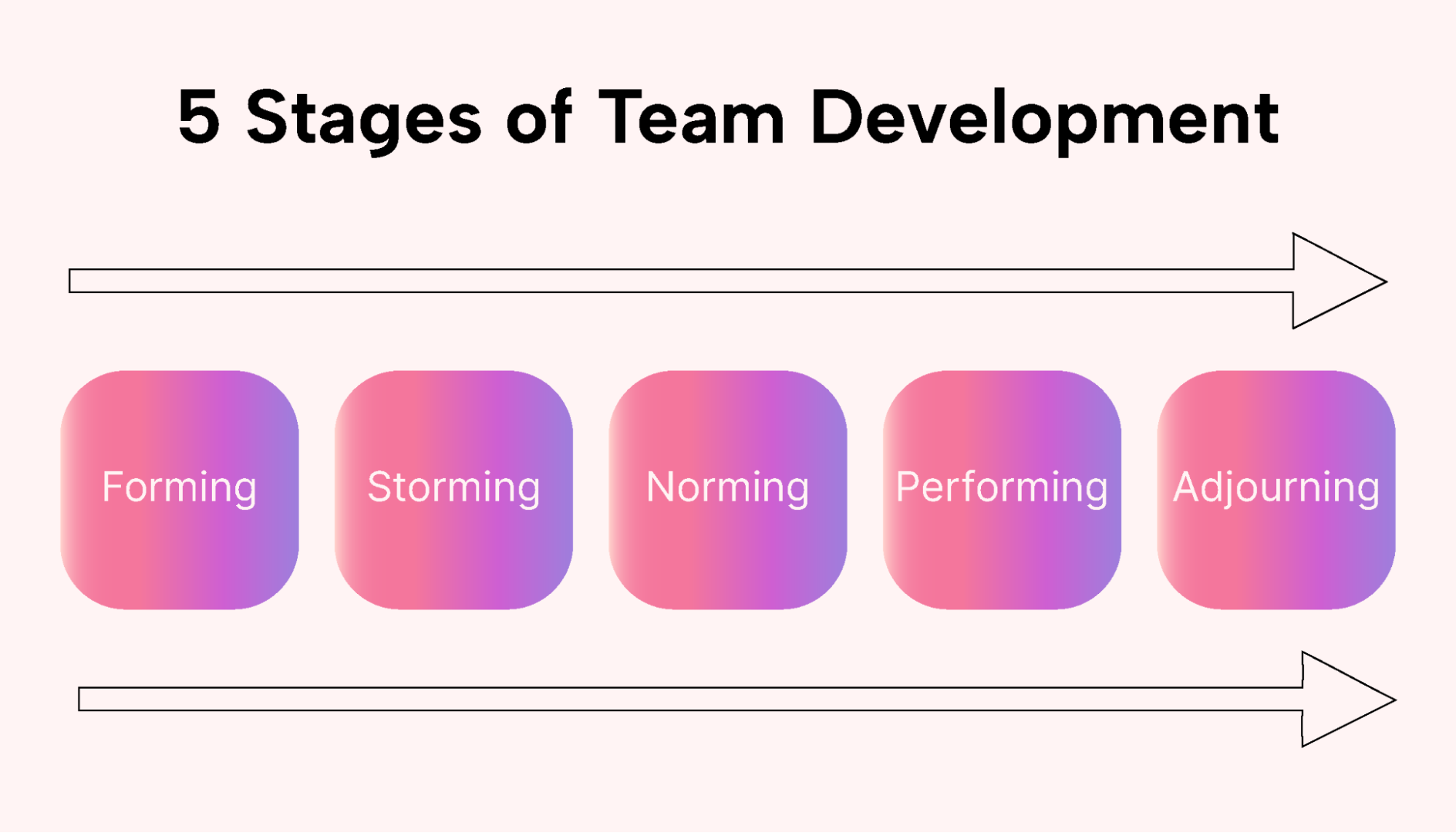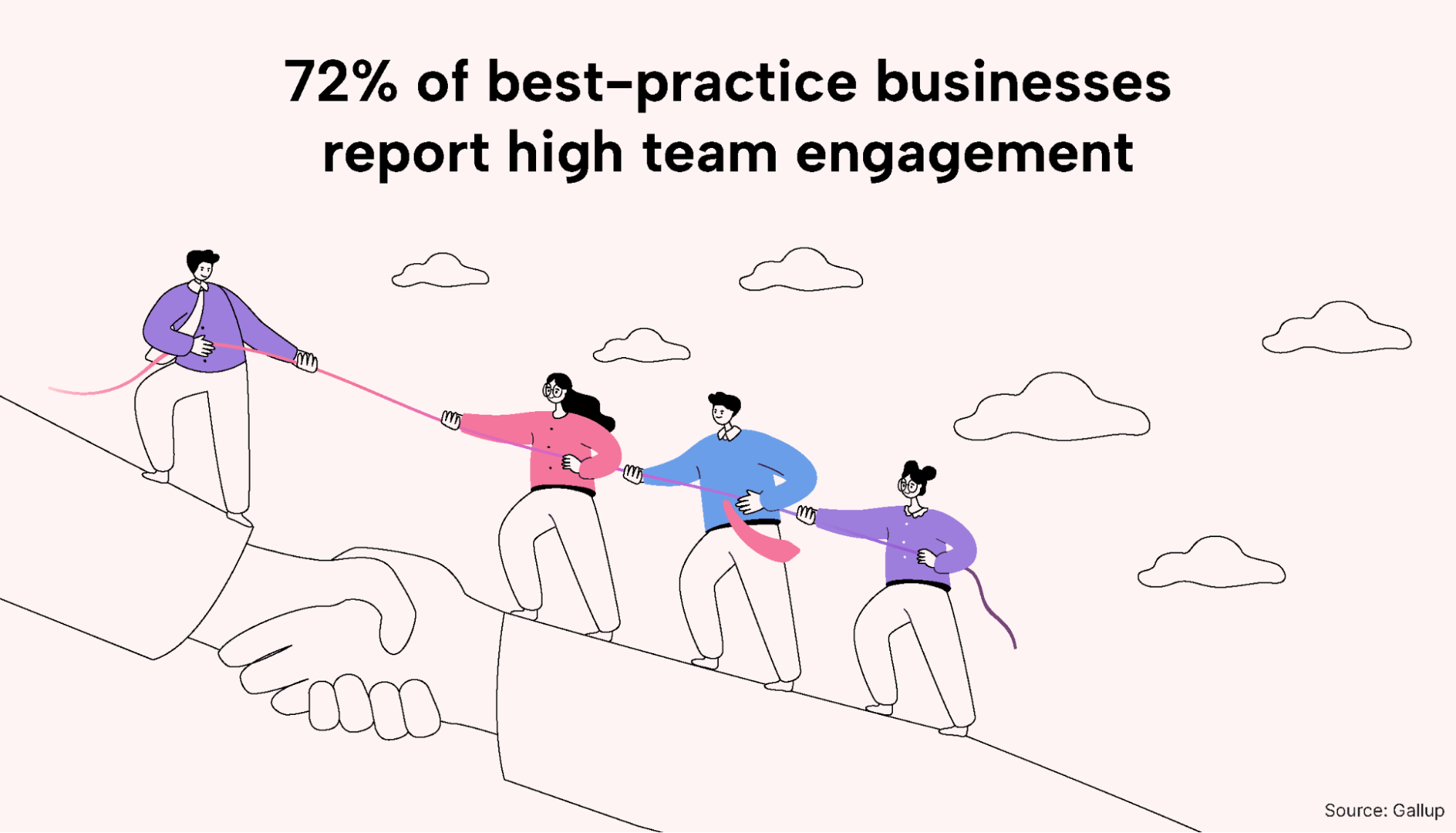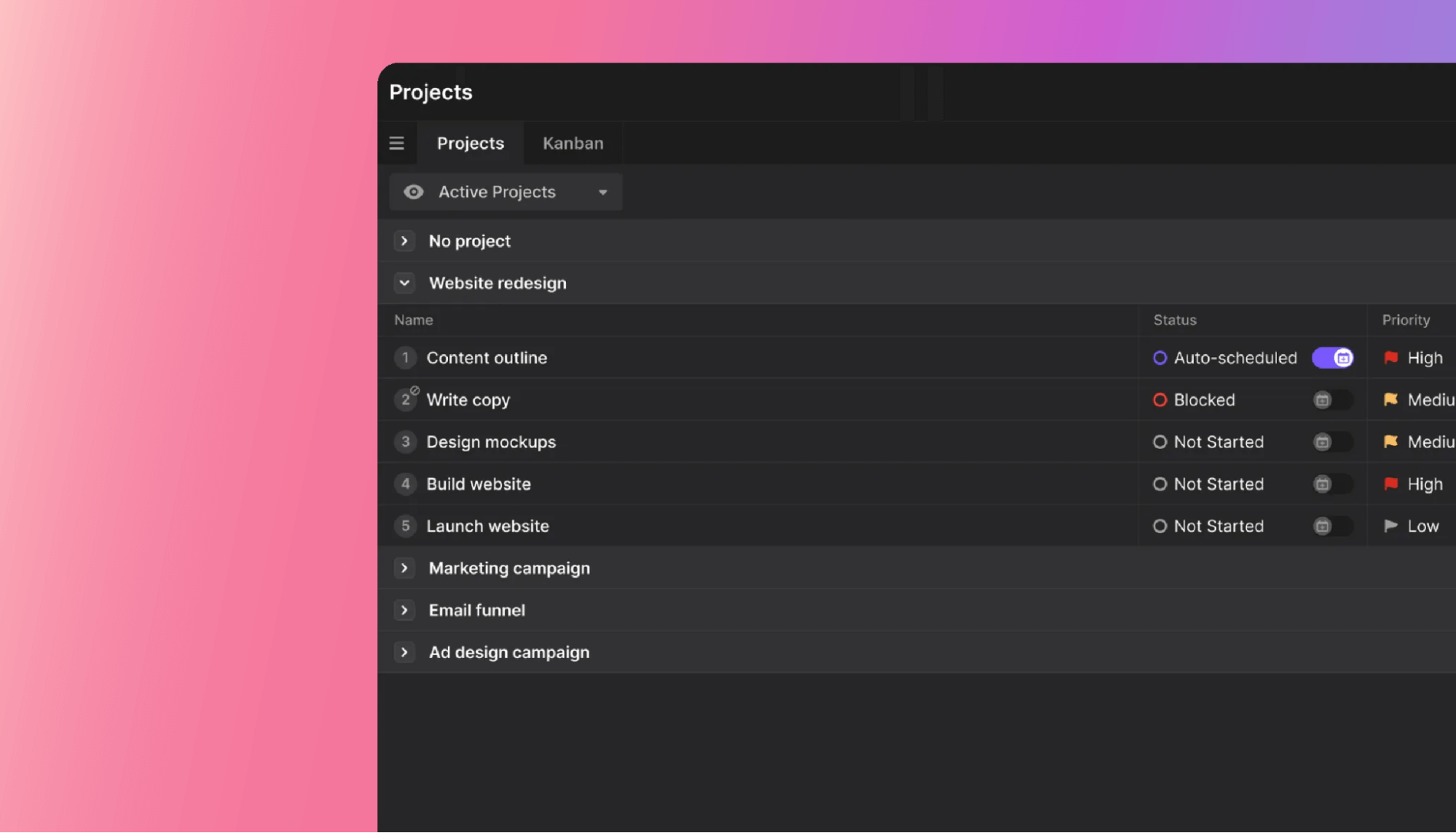Is your team continually missing deadlines or struggling to achieve its goals?
If so, then it might be time to learn more about the stages of team development.
Tuckman’s stages of team development describe how teams begin, develop, improve, and wrap up. Learn the characteristics of each stage and some practical ways to support your team members throughout the process.
Tuckman’s theory for the stages of team development
Bruce Tuckman, a professor of educational psychology at Ohio State who researched the psychology of group dynamics, developed his stages of team development theory in the 1960s.
Tuckman’s original model, published in 1965, included the first four stages: forming, storming, norming, and performing. In 1977, Mary Ann Jensen, a colleague of Tuckman’s, added the fifth stage, adjourning.
 |
The theory provides insights into how productive teams form and develop over time. It also reminds us that teams are never high-performing and ready to go from the onset. Instead, they need time to form a cohesive unit that can achieve results.
While Tuckman’s theory was developed decades ago, it remains relevant to today’s teams-based workforce.
Here’s what the five stages of team development look like in the workplace:
The 5 stages of team development
The five stages of team development have remained consistent over the years. Let’s go into each of them in detail.
1. Forming
The forming stage occurs when the team members initially come together. A team leader is established, and the various members learn their roles and responsibilities. Project goals, objectives, and timelines for the team are discussed.
The team members typically get to know each other during this initial stage. Relationships start to form as they identify strengths, weaknesses, and shared interests.
It’s common to see uncertainty and apprehension during the forming stage. The team is still learning how its different members will work together and fit in.
You may see excitement and anticipation as the team forms, too. Expect to hear a lot of questions as roles and responsibilities become clarified.
While the team may show initial signs of positive interactions, they will need time to develop an authentic rapport and trust in each other.
2. Storming
In the storming stage, people are starting to feel more comfortable with their roles.
The initial excitement of joining the group wanes as the members start to feel the weight of their projects or raise concerns about their responsibilities.
Team members typically become less polite while storming, especially if frustrations or tensions are starting to mount. While increased conflict is natural at this stage, you may notice some relationships fracturing if the team can’t resolve their issues.
Expect to see leadership decisions questioned more in the storming stage, too. If roles and responsibilities are unclear or project workload and deadlines appear unmanageable, members will start to push back against the designated authority.
At this stage, the members are still establishing their roles within the team and may function independently rather than immersing themselves in the team dynamic.
3. Norming
In the norming stage, the team is starting to come together.
Members better understand their roles and how they contribute to the team. They know their teammates better, too.
The team members may also get together socially at this stage.
Most of the questions from the storming stage have been answered, and lingering conflicts have been resolved successfully. If additional disputes arise, the team can typically address and solve them more quickly.
The team supports their leadership and is comfortable asking questions or raising concerns.
Team performance improves as members start to work more collaboratively within the group and demonstrate more confidence in their abilities. Trust also strengthens in the norming stage as the team members increasingly engage with and rely on each other.
The team is now highly focused on the project goals and objectives.
4. Performing
The performing stage is where each team ultimately wants to end up.
 |
In this stage, productivity, efficiency, and communication among team members are high, and everyone works well together in clearly defined roles. The team members have solid trust in each other and show empathy and support to others when needed.
Management can often take a step back at this point, as the team is able to work independently toward the project goal without needing frequent oversight.
The team members may also feel a renewed sense of commitment to their goals or project.
Excitement and enthusiasm return as the team gets closer to reaching its objectives. You’ll also note the boost in confidence that comes with hitting deadlines and achieving targets.
The performing stage typically indicates that the project is nearing completion.
5. Adjourning
The adjourning stage occurs when the goals have been achieved or the project completed.
Also known as the mourning stage, this is when the team realizes that their objectives are met, and the unit itself is no longer needed.
Team members who have established close relationships with each other or who have identified a strong sense of connection with the project may struggle with this phase. You may notice sadness or a sense of loss, for instance, since the project is over. The team members may also express uncertainty or anxiety about their next steps or future organizational roles.
Here, leadership is tasked with evaluating the team’s effectiveness and acknowledging its members’ efforts, including any celebration or recognition to provide a sense of closure.
Understanding the five stages of team development is the first step toward establishing highly productive teams.
Let’s discuss how you can put this understanding into practice.
What are the best strategies for supporting the team development process?
Here are some ways to support your workers as they move through the different team development stages:
Start on the same page
Begin your efforts in the forming stage as you gather everyone together.
 |
Plan an initial meeting to introduce the team members to each other so they can start putting names to faces if they haven’t already.
Clearly state the team’s goals, objectives, timelines, and deadlines. Reiterate your business’s mission and values so the team can see how this project aligns with them.
Set your expectations for each individual and the group. Outline how the team members will communicate if they need to ask questions, raise concerns, and report on their progress.
If you are kicking off a new project, include a project pre-mortem. This gives your team a heads-up by identifying potential risks and challenges, including the steps you’ll need to take to address them.
Assign team member roles
You’ll identify and assign team member roles during the forming stage.
However, you may also need to continue offering support at this point. This is typically when questions about roles, leadership, and planning emerge, so you’ll want to be prepared to address them immediately.
As you assign the roles, you’ll evaluate each of your team member’s strengths and how they will contribute to the project. Some team roles and responsibilities will be clear based on the project and the employee’s title. That being said, make sure to play to each person’s overall skills and abilities, too. Check in with them about their long-term goals for their roles within the company and determine if they’re ready for a challenge.
Ask the team members for their input, especially during the forming stage. If you don’t assign a member a role they’d wished for, tell them why. Clarify those decisions immediately if you see signs of disappointment or frustration with assignments and responsibilities.
Check in with your team to ensure you give them the level of support they need. Ensure they feel confident to approach management for help or reach out to fellow team members for encouragement.
Establish team norms
Start focusing on team norms right away. These ground rules should be discussed and established as the team forms.
You’ll also confirm and reiterate these norms as the team moves into the storming stage. By the time you arrive at the norming stage, your members will support and adhere to the team norms.
Consider the different norms you’ll need to establish.
For instance, establish solid meeting norms by answering the following questions:
- Will meetings be held in person or online?
- When will they start and end?
- Who will be required to attend?
- Which roles will each member fill during meetings? Who will be the notetaker, timekeeper, and facilitator?
Establishing strong norms leads to more productive and efficient meetings.
Additionally, collaborate with your team to establish the group norms to ensure buy-in.
- How will the team members communicate concerns, questions, and updates?
- How will conflict be addressed and resolved? Provide your team with strategies for conflict resolution ahead of time.
- What are the tools, technology, and resources needed for success? If something is missing, what’s the process for obtaining it?
The norms that you develop should include your communication channels and how you’ll encourage employees to collaborate. Companies that facilitate effective communication and collaboration usually see a boost in engagement.
Ask yourself if your company employs best practices in its employee engagement. These include aligning company goals with project and team responsibilities so each employee knows how they’re contributing to the big picture. Best-practice businesses encourage collaboration and a positive workplace culture.
 |
Seventy-two percent of companies report high engagement when they employ best practices, leading to better business outcomes.
Check in regularly
Regular communication and check-ins for managers and teams are critical throughout the five team development stages.
Management should be prepared to proactively address team issues and solve problems. This is often especially crucial during the storming stage when frustrations and tensions start to rise.
Set up a meeting cadence so your employees can count on regular check-ins. Clarify the frequency, length, and type of each meeting. For example, have the team members anticipate a 30-minute team meeting weekly in addition to a daily stand-up for progress checks.
Ensure you use an effective communication channel.
 |
Use Motion’s Project Manager to streamline the process if you’re kicking off a project.
Input every aspect of the project, and Motion will build a customized schedule with priorities included for each member. It uses your parameters to determine what your team can do.
Team members can even communicate through Motion — they can easily reach out with questions, concerns, and updates.
Celebrate the wins (and the struggles)
While it’s important to celebrate your accomplishments, you also don’t want to ignore the struggles.
 |
Celebrating the wins and the losses should be part of every project stage.
Keep employee engagement high with private and public recognition. Send a quick acknowledgment of your team’s progress through email. Start your weekly team meetings with kudos to recognize milestone achievements.
In the adjourning stage, you’ll ramp it up. Plan a celebration for your employees to recognize their individual and team achievements as the project ends. This will also give them closure as they go their separate ways.
Acknowledge the struggles, too.
Identifying and solving problems is a good thing. Daniel Coyle, researcher and author of The Culture Playbook: 60 Highly Effective Actions to Help Your Group Succeed, notes:
“At companies with top-performing cultures, there’s actually slightly more tension because they’re turning toward problems together. In bad cultures, a problem comes up and people kind of turn away from it.”
Keep your team turning toward each other by celebrating the wins and addressing the struggles.
Support stronger team development with Motion
Now that you know more about the five stages of team development, take a moment to reflect on your team’s progress. Where are they in the process? How can you support them?
Don’t forget about those practical strategies, too.
Use Motion’s Project Manager to keep all members on the same page. Each project detail, including deadlines, is included to maximize the team’s productivity. With their customized, prioritized schedules, your team members will know exactly what to focus on and when.
Don’t wait to support your team. Contact Motion to start your risk-free, 7-day trial today.





